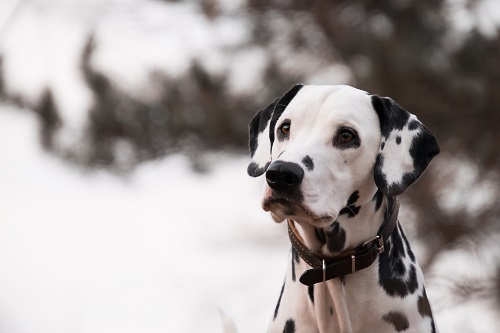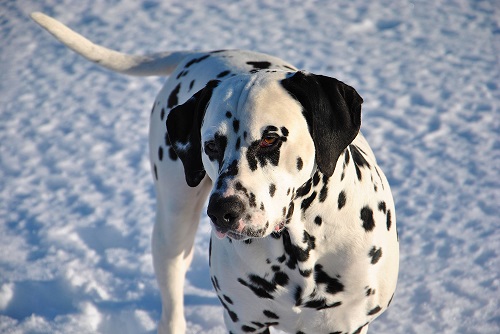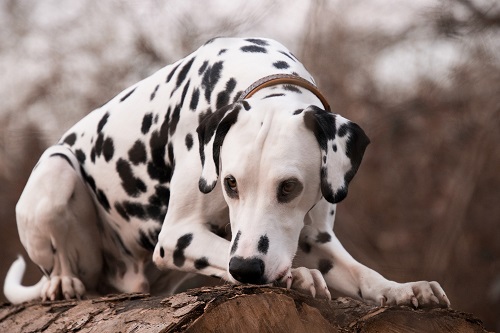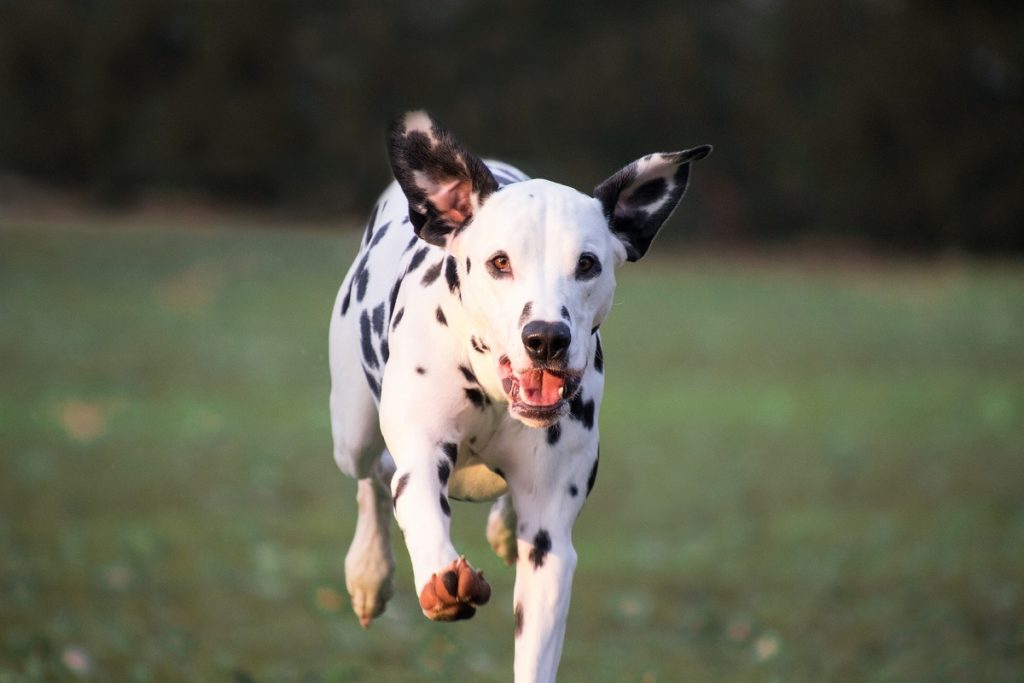Think of a dog with dots and spots, and the Dalmatian is likely the first breed to spring to mind. The characteristic black spot-splashed white coat makes them attractive and visually distinctive, and media stardom in movies like Disney’s 101 Dalmatians make them an instantly-recognizable breed.
Medium in size, sleek, and muscular, the origins of the breed are fuzzy on facts, but the name is derived from Dalmatia, a region in modern-day Croatia, where they are thought to have originated from. Many believe they share ancestry with hunting dogs like pointers, mostly due to their similarity in build and mutual love for running and exercise. Dalmatians feature a long tail that curves slightly up behind the body, and an elegant form that’s built for speed and efficient running.
Dalmatian Temperament & Personality
The temperament of a dalmatian tends to be loving, energetic, and athletic. Because of their high energy levels, they need an owner that is able to take them out on a regular basis and that can give them an active lifestyle. Another important thing to note is that Dalmatians love to be around their owners. Whether you’re cooking in the kitchen or lounging on the couch, you can expect your Dalmatian to be right by your side wherever you go. While this breed does not tend to be aggressive, they are excellent watch dogs and will warn their owners of an intruder if the occasion arises.
Speckled & Freckled Dogs: A Genetic Wonder
Looking in on a brand-new litter of Dalmatian puppies yields an unexpected surprise: nestled against the characteristically-spotted mother will be a pile of snow white babies. Dalmatians are actually born without their characteristic spots, which won’t begin to emerge for another few weeks. These spots, called piebald markings, can be the characteristic black or even a reddish-brown “liver” color, depending on a pup’s genetics. Their spots will continue to appear for months as they grow, tapering off around the seven-month mark. While adult dogs may still add spots to their coat with age, they will appear much more slowly over time.
The spots aren’t merely colorations of the fur, either: in Dalmatians, spots are literally skin deep. If his short coat were shaved off, the same spots that were on his fur will also appear on his skin. This interesting genetic trait also appears in other patterned-fur animals like the domestic tabby cat. Even the inside of a Dalmatian’s mouth has these spots, making him a very interesting-looking dog.
Dalmatians As Fire Dogs: An Honorable History
While the sirens, lights, and speed of modern fire engines help put blazes out quickly and efficiently, the original fire engines ran on an entirely different version of horsepower: actual horses. With pedestrians using the streets, an early-warning system was needed to prevent disaster in the face of trampling hooves en route to a fire: the Dalmatian. High-energy, extremely fast, and undeniably visible, this is where the relationship between Dalmatians and fire companies began. The fire company’s Dalmatian would run ahead of the fire wagon to clear the way and let passers-by know to move to the side, ensuring the vehicle would arrive quickly and without incident to the site of the blaze. 
In addition to alerting pedestrians to the wagon, the Dalmatian served an important and unexpected role: horse-thief deterrent. Dalmatians formed close bonds with the horses that pulled the fire wagons, to the end that the horses tolerated their presence very well and didn’t “spook” as they often did with other dog breeds. Horses were also very valuable in that time period, which meant that a fire company’s horses were frequent targets for theft. As the men of the fire company weren’t able to constantly stay with the horses, criminals would take advantage of the situation by swiping the horses from the stables. The company’s Dalmatian would remain with the horses overnight to ensure none of the steeds were taken, setting up a barking alarm or chasing off the thieves directly.
Today, many fire companies keep a Dalmatian as an honorary station pet to pay homage to the historical achievements of this hardworking breed. In fact, plush Dalmatian mascot meet-and-greets to teach children about fire safety are extremely common at fairs, festivals, and school visits.
Dalmatian Health Issues: What Pet Parents Should Know
Canine deafness is a common trait in base white-coated dogs – Malamutes and Huskies are also prone to both single and dual-ear hearing impairment and loss. Dalmatians as a breed have a high incidence of deafness: approximately 3 in 10 Dalmatians will have moderate to severe hearing loss, including complete deafness in about 8% of the population. This genetic predisposition led to less-than-flattering opinions that Dalmatians were unintelligent in the early days of the breed, as breeders thought the dogs simply weren’t listening to them or couldn’t keep their attention focused.
Dalmatians are also prone to two additional health concerns: canine bladder stones and coat conditions. Bladder stones occur naturally, but by ensuring he drinks plenty, a pet parent can help prevent the worst of them. Coat conditions such as canine allergies can cause some of his fur to fall out or his skin to lose pigmentation, putting him at risk for a bad sunburn with prolonged outdoor exposure. When in doubt, consult a vet to determine if he has any of these breed-specific ailments, as a medical professional can offer advice and medication specific to his condition(s).
Dalmatians & Grooming: Facts and Tips
While some breeds of dog sweat profusely or put off an unmistakable “doggy odor” even with frequent bathing, the Dalmatian is surprisingly resistant to it. The short length and quality of their coat helps dirt and dust fall off easily, which means they don’t tend to stink or smell, even with prolonged exercise. That isn’t to say he doesn’t need regular grooming for his health and well-being, but rather that his distinctive spotted coat is more likely to announce his presence than his scent.
 He is an excellent dog for the allergy-prone, but potential Dalmatian pet parents should be aware his glossy coat isn’t immune to shedding – in fact, he sheds a lot. Expect to find his little white hairs on furniture, clothing, and carpets throughout the year, and keep a lint roller handy at the front door. Periodic professional grooming or baths at home will help minimize the amount of shedding, but the Dalmatian breed isn’t a double-coated one: those surface-level shed hairs are his one and only coat. It can’t be buzzed or trimmed back, only brushed to remove loose hairs, which should be done at least once or twice a week for comfort and cleanliness.
He is an excellent dog for the allergy-prone, but potential Dalmatian pet parents should be aware his glossy coat isn’t immune to shedding – in fact, he sheds a lot. Expect to find his little white hairs on furniture, clothing, and carpets throughout the year, and keep a lint roller handy at the front door. Periodic professional grooming or baths at home will help minimize the amount of shedding, but the Dalmatian breed isn’t a double-coated one: those surface-level shed hairs are his one and only coat. It can’t be buzzed or trimmed back, only brushed to remove loose hairs, which should be done at least once or twice a week for comfort and cleanliness.
If pet parents are considering dressing up their Dalmatian with dog sweaters or costumes, the dog should be thoroughly brushed beforehand and the clothing removed periodically. Otherwise, the shed hair may build up, causing irritation and canine skin issues that linger long after the sweater or outfit is removed. Additionally, if he experiences neck irritation with a slender or chain collar, discuss harness possibilities with a vet – this will also help mitigate any pulling while out on walks.
Dalmatians & Living Spaces: Identifying His Activity Requirements
As much as they are loyal and loving, Dalmatians are built to run – keep him cooped up for long enough, and this desire will become unmistakably clear. Their long, sleek build and ergonomic shape motivate them at the genetic level to zoom across large distances like fenced-in yards and dog parks in exhilarating chases or play. Apartment-dwelling is generally not a good idea with this breed, as they’re naturally high-energy and need to be walked and exercised several times a day to stay happy and calm indoors. Without a yard to run around in or an active pet parent to keep pace with, he will quickly grow bored and restless – and in turn, possibly destructive.
This desire for frequent activity may taper with age, but a Dalmatian puppy or young adult shouldn’t be kept indoors for long periods of time unless it’s absolutely necessary. It will lead to canine anxiety or depression in this active breed, and it may take him a while in a more suitable environment to feel like his old self again. Dalmatians are notorious “pouters” with long memories – a trait that makes initial training easier, but later bouts of sullen behavior hard to deal with.
When a Dalmatian is kept indoors, he should be provided with as large a space as is feasible – he generally won’t do well in a confined crate or cage unless it’s used for sleeping only. His muscles are built for moving, walking, and running, and confining him suppresses his natural instincts in an uncomfortable way.
Dalmatians & Children: Understanding The Breed
Though Dalmatians are frequently portrayed in movies and television shows as companions for young children, experts generally advise against the pairing. While not necessarily overly muscular, Dalmatians are still strong dogs with long legs, and if they rear up during play, they could easily knock down smaller children. In addition to their rearing height, they are also very fast dogs, and running past a child at full speed could lead to injuries from collisions or falling down. Dalmatians, even puppies, are best paired with teen or adult handlers that are prepared to manage the breed’s high energy and need for exercise.
While Dalmatians aren’t particularly aggressive or dangerous around children, their tendency towards hyperactivity may make the situation a bit much for parents to handle. Older, socialized Dalmatians may make good companions for the family, but these matches should always be explored cautiously, particularly if the Dalmatian in question is a rescue dog of unknown origins.
Dalmatians & Adults: Dog Ownership and Socialization Guidelines
For the same reasons Dalmatians and children don’t mix well, elderly or physically disabled pet parents might want to think twice before bringing a Dalmatian home. The breed’s exercise needs combined with their enthusiastic play habits could be overwhelming to manage. For older adults and childless couples, however, Dalmatians make an excellent choice for a pet:
- They seldom bark: While each Dalmatian is different, they are considered a “gentleman/woman dog” because of their reluctance to bark for the sake of barking. He will naturally alert to an intruder, but he won’t generally bark out of boredom.
- They’re a good allergy choice: While it’s true that he will shed profusely, that shed won’t come with an abundance of irritating dog dander. Pet parents prone to sniffles around “fluffier” dog breeds should feel sniffle-free in the company of a Dalmatian.
- They’re good watchdogs: While he might not be guarding fire horses anymore, that doesn’t mean the old instincts aren’t alive and well. Intruders are no match for the alert, intelligent Dalmatian, even if he does happen to be one of the 30% affected by hearing loss. Good vision and acute physical senses can help close that gap.
- They aren’t particularly destructive: While they admittedly hate being cooped up, they’re typically content to keep their chewing confined to a favorite toy unless they’re actively trying to get out. While they can be guilty of being “diggers” outside, if he’s a well-trained and appropriately-supervised pup, the gardens should stay intact.
- They’re always ready for a run or hike: Dalmatians are an ideal companion for an active pet parent, as their stamina ensures that even long hikes are a pleasurable excuse for companionship. Just like humans, as long as he’s well-fed, hydrated, reasonably protected from the sun, and allowed to rest along the way, he has boundless stamina potential out on the trail.
Is A Dalmatian A Good Dog Choice?
The best answer to this question is that a Dalmatian can be a good choice for a pet, but only in specific situations where their basic needs are met. He needs to have room to run, frequent human companionship, and a household committed to brushing him regularly in order to be happy and healthy. While there will always be exceptions, Dalmatians do not generally make good pets for children, families with young children, or the elderly, nor are they good apartment or condo-dwelling dogs.
As far as pet siblings go, a Dalmatian does well as an ‘only dog’ or paired with a dog breed that’s similarly energetic and active. Mismatched age ranges can result in a young Dalmatian irritating an older, calmer dog or vice-versa. Because of their history with horses, Dalmatians have the potential to be excellent farm dogs, so long as they are slowly and carefully introduced to the animals around them.
As long as he is examined periodically by a vet to rule out common breed ailments, he will live a long, healthy life of between ten and fifteen years – providing his pet parents with as many memories of love, laughs, and smiles as there are spots on his beautiful white coat.
Sources Cited:
- “Dalmatian Dog.” Wikipedia.org, (no publish date), https://en.wikipedia.org/wiki/Dalmatian_dog. Accessed September 23, 2019.
- “Looking for a Playful, Loyal Running Buddy That Will Guard You Too?” Healthy Pets.Mercola.com, November 15, 2017, https://healthypets.mercola.com/sites/healthypets/archive/2017/11/15/dalmatians.aspx. Accessed September 23, 2019.
- “Dalmatian.” American Kennel Club (AKC.org), (no publish date),https://www.akc.org/dog-breeds/dalmatian/. Accessed September 23, 2019.




